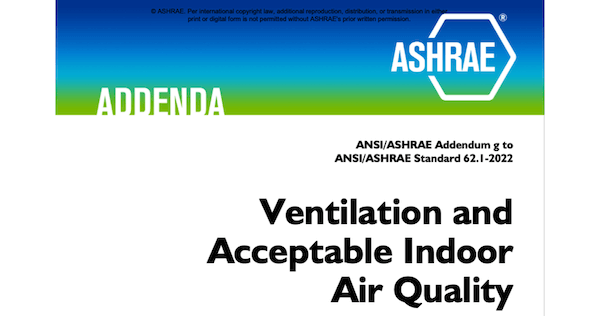Latest Update to ASHRAE 62.1 Simplifies Process to Qualify Gas-Phase Air Cleaning Technologies

 In October 2024, ASHRAE published another addendum to Standard 62.1-2022, Ventilation and Acceptable Indoor Air Quality, to simplify the process to qualify gas-phase air cleaning technologies used with the IAQ Procedure or IAQP. This latest update, which is called Addendum g, “provides additional templates to document air cleaning systems used in compliance with the indoor air quality procedure in Section 6.3.”
In October 2024, ASHRAE published another addendum to Standard 62.1-2022, Ventilation and Acceptable Indoor Air Quality, to simplify the process to qualify gas-phase air cleaning technologies used with the IAQ Procedure or IAQP. This latest update, which is called Addendum g, “provides additional templates to document air cleaning systems used in compliance with the indoor air quality procedure in Section 6.3.”Unlike the prescriptive Ventilation Rate Procedure or VRP, which is the alternative to the IAQP to calculate mechanical ventilation rates for space types covered by Standard 62.1, the IAQP allows for qualified air cleaning systems to be used to clean and recirculate return air so that outside air requirements may be reduced without compromising indoor air quality. Reducing outside air using the IAQP with air cleaning reduces the conditioning load on buildings. This allows buildings to install smaller HVAC systems that cost less money and use less energy. Electrifying buildings also becomes easier when HVAC loads and associated electrical loads are reduced.
In 2022 and 2023, ASHRAE published three major addendums to Standard 62.1 to encourage the use of the IAQP. These updates made the IAQP more prescriptive, which makes it simpler and less risky for engineers to apply. Click here to learn more about these three addendums.
Addendum g is the latest update to Standard 62.1 designed to encourage the use of the IAQP by making the procedure simpler and less risky for engineers to apply. Addendum g does this by providing templates in Informative Appendix I to document compliance of mechanical fibrous filters, sorbent filters, and other types of filtration and air cleaning systems used with the IAQP, as required by Section 6.3.4 (see Addendum n to 62.1-2022).
Mechanical fibrous filters and/or sorbent filters
Other types of gas-phase air cleaners
Alternatively, the third template in Informative Appendix I, which is also shown below, may be used by engineers and code officials to confirm the compliance of air cleaning systems based on other types of filtration and air cleaning systems such as electronic air cleaners and ionization. When these types of systems are applied, users can check which ASHRAE or ISO standards have been used to determine air cleaning efficiencies for all the compounds and PM2.5 in Table 6-5 or indicate that another national consensus standard approved by the local AHJ or custom efficiency test approved by the local AHJ has been used to determine air cleaning efficiencies for all the compounds and PM2.5 in Table 6-5.
As can be seen in the third template, when custom efficiency tests are used there are additional boxes that must be checked to confirm that the custom efficiency test complies with Section 6.3.4(e) from 62.1-2022 Addendum n. This section in 62.1-2022 states that these requirements must be met “for all compounds included in the design”, which means all compounds found in Table 6-5 and any other compounds that may be included in the design, and that the custom efficiency test “shall be documented and approved by the authority having jurisdiction.”
Given the additional requirements and risks for engineers using air cleaning systems that require the use of other “national consensus standard” approved by the AHJ or “custom efficiency test” approved by the AHJ, the simplest approach from a compliance standpoint is to use air cleaning technologies with ASHRAE Standard 145.2 and ASHRAE Standard 52.2 efficiencies for all the compounds and PM2.5 included in Table 6-5 and any other compounds that may be included in the design calculations.
Click here to access a free version of enVerid’s IAQP Air Cleaner Compliance Checklist and click here to view the efficiencies for enVerid’s sorbent filters for all the compounds and PM2.5 included in Table 6-5. These efficiencies have been determined based on third-party testing according to ASHRAE Standards 145.2 and 52.2.

Christian Weeks
CEO, enVerid Systems
Subscribe to our blog





